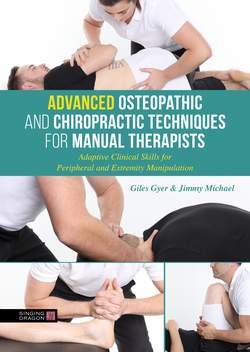Advanced Osteopathic and Chiropractic Techniques for Manual Therapists

Реклама. ООО «ЛитРес», ИНН: 7719571260.
Оглавление
Giles Gyer. Advanced Osteopathic and Chiropractic Techniques for Manual Therapists
Introduction
Discussion. Relationship between biomechanical changes and neurophysiological responses of a given spinal manipulation
Neurophysiological effects of spinal manipulation
Neuromuscular effects. Muscle activation
Modulation of gamma motor neuron activity
Modulation of alpha motor neuron activity
Autonomic responses
Significance of ANS changes following manipulation
Effects of manipulation-induced autonomic changes on supraspinal mechanisms
Co-activation of the neuroendocrine system
Hypoalgesic effects
Segmental inhibition
Activation of descending pain inhibitory pathways
Non-specific cerebral responses
Temporal summation
Conclusion
References
Introduction
Current theoretical basis
No neurological connection between the spine and organs: A brief rebuttal
Misunderstanding, or intentional misinterpretation?
References
Introduction
Intrarater and interrater reliability of motion palpation
Reliability of osteopathic motion palpation tests
Conclusion and recommendations
References
Introduction
Joints
Range of motion
Common neck injuries
Red flags
Special tests
References
Seated C2–C7 manipulation
Recumbent C2–C7 manipulation
Prone C2–C7 manipulation
Side-lying C2–C7 manipulation
Side-lying occipital-atlantal and atlantal-axial (OA–AA) manipulation
Seated OA–AA manipulation
Prone OA–AA manipulation
TMJ thumb and chin-hold manipulation
TMJ chin contact
TMJ manipulation using pisiform or thenar eminence
TMJ manipulation using reinforced thenar eminence
Introduction
Joints
Range of motion
Common injuries
Red flags
Special tests
References
Prone cervico-thoracic junction manipulation
Side-lying cervico-thoracic junction manipulation, contra-lateral side
Seated cervico-thoracic junction manipulation, suboccipital and mastoid contact
Supine ipsilateral thoracic manipulation, T2–T12
Single supine thoracic manipulation, T2– T12
Recumbent supine thoracic manipulation, T2–T12
Rolling supine ipsilateral thoracic manipulation, T2–T12
Reinforced rolling supine ipsilateral thoracic manipulation, T2–T12
Prone thoracic thrust – ‘butterfly’, with body drop, T2–T10
Prone thoracic spear technique with body drop, T2–T12
Prone thoracic spear technique body drop with extension, T2–T12
Single hand thoracic manipulation, T2–T12
Double hand thoracic manipulation, T2–T12
Standing ipsilateral thoracic manipulation, T2–T12
Introduction
Joints
Range of motion
Common injuries
Red flags
Special tests
References
Seated acromioclavicular (AC) joint (muscle energy technique and HVLA thrust technique)
Seated acromioclavicular (AC) joint (muscle energy technique and HVLA thrust technique)
Seated superior to inferior glenohumeral (GH) and acromioclavicular (AC) joint HVLA
Seated superior to inferior glenohumeral (GH) and acromioclavicular (AC) joint HVLA in flexion
Seated superior to inferior glenohumeral (GH) and acromioclavicular (AC) joint HVLA in flexion with straight arm
Seated superior to inferior glenohumeral (GH) and acromioclavicular (AC) joint HVLA in abduction with straight arm
Supine superior to inferior glenohumeral (GH) and acromioclavicular (AC) joint HVLA in abduction
Supine anteroposterior glenohumeral (GH) and acromioclavicular (AC) joint HVLA in abduction
Supine distal anteroposterior glenohumeral (GH) and acromioclavicular (AC) joint HVLA in abduction
Seated clavicle lift technique
Prone ipsilateral rib, R1–R3
Supine contra-lateral anterior rib, R1–R5
Prone 1st rib in extension
Supine contra-lateral posterior rib rotation, R3–R6
Supine contra-lateral posterior rib manipulation, R1–R6
Seated posterior rib manipulation, R1–R4
Seated posterior rib manipulation sternum contact, R2–R4
Introduction
Joints
Range of motion
Common injuries
Red flags
Special tests
References
Humeral ulnar joint – seated
Radial head – seated with thumb contact
Radial head – seated with pisiform contact
Radial head – seated with pisiform contact
Prone radial head manipulation
Seated long-axis distraction of the humeroradial joint
Long-axis radial head manipulation using a fulcrum
Prone, posterior to anterior humeral ulnar joint
Seated, posterior to anterior humeral ulnar joint
Supine, medial to lateral gapping of the humeroulnar joint
Supine, lateral to medial gapping of the humeroulnar joint
Seated, lateral to medial gapping of the humeroulnar joint
Seated, lateral to medial gapping of the humeroulnar joint
Prone, medial to lateral gapping of the humeroulnar joint
Prone, lateral to medial gapping of the humeroulnar joint
Thumb/1st MCP manipulation
Carpal manipulation – inferior drive
Carpal manipulation – superior drive
Distal ulnar
Distal radius
Introduction
Joints
Range of motion
Common injuries
Red flags
Special tests
References
Lumbar spine manipulation with rotation, L1–L5/S1
Lumbar spine body drop manipulation with rotation, L1–L5/S1
Lumbar spine PSIS contact no rotation, L1–L5/S1
Lumbar spine thenar contact on specific segment or PSIS no rotation, L1–L5/S1
Lumbar spine recumbent kick start with or without rotation, L1–L5/S1
Lumbar spine manipulation modified with or without rotation and hip flexion, L1–L5/S1
Lumbar spine manipulation seated, L1–L5/S1
Introduction
Joints
Range of motion
Common injuries
Red flags
Special tests
References
Supine proximal femoral head manipulation
Supine proximal femur manipulation with external rotation
Prone proximal femoral head manipulation
Prone proximal femoral head manipulation
Side-lying proximal femoral head manipulation
Side-lying proximal femoral head manipulation with external rotation
Supine proximal femur manipulation with compression and internal rotation
Unilateral pubis manipulation with hip extension
Introduction
Joints
Range of motion. Knee
Ankle
Foot
Common injuries
Red flags
Special tests
References
Supine fibula head thrust, bilateral hand contact
Prone fibula head thrust, pisiform hand contact
Prone fibula head thrust, MCP contact
Prone fibula head thrust, forearm contact
Prone knee thrust, posterior to anterior glide of the left tibiofemoral joint
Supine knee thrust, traction thrust for the tibiofemoral joint
Medial to lateral and lateral to medial thrust of the right tibiofemoral joint
Prone knee thrust, traction thrust for the tibiofemoral joint
Supine proximal tibia anterior thrust
Supine proximal tibia thrust posterior, wedge technique
Supine cuneiform manipulation
Supine tibio-talar manipulation
Metatarsal head manipulation
Supine talus manipulation
Supine navicular manipulation
Medial cuneiform and 1st metatarsal manipulation
Supine navicular manipulation with extended leg
Side-lying navicular manipulation with knee in flexion
Proximal 1st metatarsal with knee flexion
Hallux manipulation
Calcaneum manipulation in prone
Tibio-talar manipulation
Talocrural manipulation
Cuneiform manipulation
Cuboid manipulation
Cuboid manipulation pisiform contact
Cuboid manipulation thumb content
Technique contributors
Supporting contributors
Images
Отрывок из книги
ADVANCED OSTEOPATHIC
AND CHIROPRACTIC TECHNIQUES
.....
Dishman, J.D., Cunningham, B.M. and Burke, J. (2002) ‘Comparison of tibial nerve H-reflex excitability after cervical and lumbar spine manipulation.’ Journal of Manipulative and Physiological Therapeutics 25(5), 318–325. Available at www.ncbi.nlm.nih.gov/pubmed/12072852
Dishman, J.D., Dougherty, P.E. and Burke, J.R. (2005) ‘Evaluation of the effect of postural perturbation on motoneuronal activity following various methods of lumbar spinal manipulation.’ The Spine Journal 5(6), 650–659. Available at www.ncbi.nlm.nih.gov/pubmed/16291107
.....